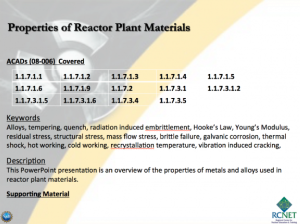RCNET ACAD 08-006 Crosswalk: 1.1.7 Core Curriculum - Properties of Reactor Plant Materials

Program Description:
This material was published by the Regional Center for Nuclear Education and Training (RCNET) as part of a comprehensive crosswalk that links objectives of ACAD 08-006 with GP Strategies ABC Material, NUCP Surveyed Material, NANTeL resources, EPRI resources, web resources, and published material available to all RCNET partners. These accredited utility training programs are based of training and qualification guidelines (ACADs) published by the National Academy for Nuclear Training.
ACAD 08-006 is the Uniform Curriculum Guide for Nuclear Power Plant Technician, Maintenance, and Nonlicensed Operations Personnel Associate Degree Programs and includes five main curriculum areas: Core Curriculum, Discipline-Specific Curriculum for Nonlicensed Operators, Discipline-Specific Curriculum for Radiological Protection Technicians, Discipline-Specific for Chemistry Technicians, and Discipline Specific for Maintenance Personnel.
Contents:
The Core Curriculum is divided into three sections: Fundamentals, Basic Systems Knowledge, and Basic Components Knowledge. This Properties of Reactor Plant Materials section of Fundamentals (ACAD 08-006 1.1.7) covers "... the basic concepts of the properties of metals and alloys; the strength of materials; brittle fracture; plant material problems; thermal shock stress; erosion, corrosion, and control."
Documents associated with ACAD 08-006 1.1.7 include two PowerPoint presentations.
This material covers, more specifically: basic material properties including: alloy definition and application, compressive strength, expansion/contraction associated with temperature changes; heat treating and annealing related to the properties of metals; radiation-induced embrittlement by neutron exposure; material strength; structure basics and changes in structure (overview of general metals properties, not a discussion of crystalline structure); torque limits; and yield and tensile strength. Materials also cover brittle fracture characteristics, mechanisms, and temperature effects such as heatup and cool down; plant material problems, including corrosion types including general and specific, microbiological-induced corrosion (open system sources such as marine growth), pit and crevice, galvanic, chloride stress, caustic stress, stress corrosion cracking, and more.
About this Resource


Comments